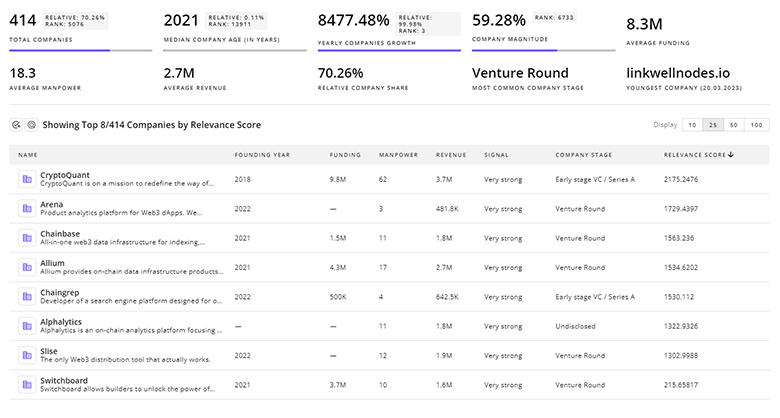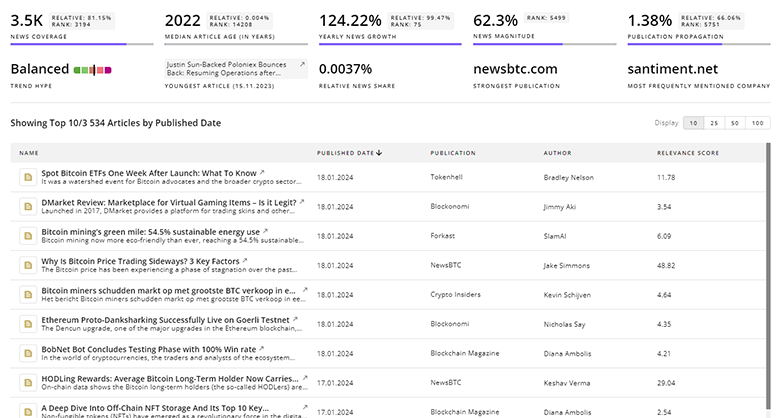
Chemical & Petrochemical Industry Report
: Analysis on the Market, Trends, and TechnologiesThe chemical and petrochemical industry sits on a large growth trajectory: global petrochemical market sizing is estimated at USD 666.28 billion in 2024 with a baseline CAGR of 7.4% to 2037, signaling continued expansion but uneven regional dynamics and margin stress in Europe; European petrochemical margins fell to about -12% in Q1 2024 and may recover only modestly with capacity rationalization, according to market analysis and industry outlooks 2025 Chemical Industry Outlook – Deloitte Insights Petrochemical Market Size & Share | Industry Report, 2030.
We updated this report 15 days ago. Noticed something’s off? Let’s make it right together — reach out!
Topic Dominance Index of Chemical & Petrochemical Industry
The Topic Dominance Index trendline combines the share of voice distributions of Chemical & Petrochemical Industry from 3 data sources: published articles, founded companies, and global search
Key Activities and Applications
- Feedstock diversification and circular feedstocks: transition programs to integrate bio-based feedstocks, PCR (post-consumer recycled) polymers, and chemical recycling are active across projects and pilots
- Large-scale polymer capacity expansions (PE/PP): major buildouts and brownfield debottlenecks aim to meet packaging and automotive demand; North America and Asia remain focal regions for capacity investments
- Process engineering, plant modernization and EPC services: front-end engineering, revamps, modularization and process-intensification projects accelerate to shorten lead times and reduce capital intensity Petro Project Engineering, Inc.
- Advanced recycling and waste-to-feedstock operations: thermal and chemical recycling pilots convert low-grade and mixed plastics back into hydrocarbon feedstocks validated by petro-majors for closed-loop use researchnester – Petrochemical Market.
- Specialty and high-performance intermediates: expansion in additives, coatings, and electronic-grade chemistries that deliver margin uplift versus commodity chains.
Emergent Trends and Core Insights
- Regional capacity shift to Asia and the Middle East is concentrating incremental global supply; Asia will capture a dominant share of new ethylene/propylene builds and downstream polyolefin capacity through 2030 Petrochemicals Market Growth Analysis Report.
So what: firms competing in Western markets face margin pressure and must either differentiate into specialty streams or pursue integrated supply alliances. - Profitability recovery in Europe depends on near-term asset rationalization and digital OPEX cuts; models show modest margin gains if structural capacity reductions and digitalization reduce operating cost bases
So what: capital allocation will favor plants with decarbonization retrofit potential and strong feedstock access. - Sustainability-led product strategies: bio-ethylene, bio-glycols and carbon-negative polypropylene concepts gain traction via licensing and commercial pilots; CCUS and electrified processes are moving from demonstrations to early commercial cases Sustainable Feedstocks and Facility Integration Shape the Petrochemical Industry.
So what: buyers and regulators increasingly price low-carbon attributes into sourcing decisions; first movers can capture premium contracts. - Digital operations and AI for asset optimization: targeted deployments (digital twins, predictive maintenance) produce measurable OPEX reductions and yield improvements in early adopters
So what: digital ROI shortens payback for retrofits and supports tighter margin management in commodity cycles. - Recycling and chemical upcycling scale-up: continuous pyrolysis and catalytic processes (patented modular approaches) lower CAPEX intensity and create feedstock alternatives to naphtha/ethane
So what: companies that secure validated recycled feedstock supply chains reduce exposure to crude price swings and mounting regulatory pressure on virgin plastics.
Technologies and Methodologies
- Carbon Capture, Utilization and Storage (CCUS) and CCU-enabled product lines: retrofits and integrated CCU+chemistry pathways aimed at carbon-negative polypropylene and methanol syntheses.
- Electrified and power-to-X process modules: modular electrified reactors and electrochemical synthesis for green methanol, green hydrogen integration and low-temperature olefin routes.
- Advanced catalysis and mesoporous zeolite optimization for higher selectivity in cracking and aromatics production, reducing energy per ton and lowering byproduct streams [Patent Landscape Report data].
- Continuous-flow and microstructured reactors for specialty/fine chemicals to shorten scale-up timelines and reduce CAPEX compared with conventional batch systems.
- Chemical recycling platforms (continuous pyrolysis, depolymerization and catalytic upgrading) validated for producing hydrocarbon oils convertible to virgin polymer feedstocks
Chemical & Petrochemical Industry Funding
A total of 4.0K Chemical & Petrochemical Industry companies have received funding.
Overall, Chemical & Petrochemical Industry companies have raised $605.7B.
Companies within the Chemical & Petrochemical Industry domain have secured capital from 11.3K funding rounds.
The chart shows the funding trendline of Chemical & Petrochemical Industry companies over the last 5 years
Chemical & Petrochemical Industry Companies
- PolyCycl — PolyCycl commercializes a patented, fully continuous pyrolysis process that converts mixed, hard-to-recycle plastics into hydrocarbon oils validated by petro-majors for virgin plastics manufacture; the company emphasizes low CAPEX modular plants and holds multiple international patents that support scale-up economics and feedstock flexibility
- Reaction35, LLC — Reaction35 focuses on chemical waste stream recovery and process development to reclaim valuable intermediates from manufacturing effluents; the firm targets circularity for textile, fertilizer and fine-chemicals producers and emphasizes implementation plans that recover revenue from what were disposal streams
- Petron Scientech — Petron Scientech licenses conversion technologies that transform renewable ethanol into bio-ethylene, bio-glycols and bio-polyethylene; their process claims lower utilities consumption and near-carbon-neutral lifecycle footprints, positioning them where demand for drop-in renewable monomers grows
- IOSYA — IOSYA provides AI-driven digital twins and process-optimization solutions tailored to the chemical industry; the company reports multiple digital twin implementations with measurable CO2 reductions per ton of product and yield improvements from real-time control layers
- Peiyang Chemical Equipment Co. Ltd. — Peiyang supplies rectifying column packings, internals and modular refinery equipment; the company enables faster EPCC and modular plant deployment for smaller, regional petrochemical complexes where lower upfront CAPEX and rapid installation matter
Gain a better understanding of 65.5K companies that drive Chemical & Petrochemical Industry, how mature and well-funded these companies are.

65.5K Chemical & Petrochemical Industry Companies
Discover Chemical & Petrochemical Industry Companies, their Funding, Manpower, Revenues, Stages, and much more
Chemical & Petrochemical Industry Investors
Gain insights into 9.0K Chemical & Petrochemical Industry investors and investment deals. TrendFeedr’s investors tool presents an overview of investment trends and activities, helping create better investment strategies and partnerships.

9.0K Chemical & Petrochemical Industry Investors
Discover Chemical & Petrochemical Industry Investors, Funding Rounds, Invested Amounts, and Funding Growth
Chemical & Petrochemical Industry News
Gain a competitive advantage with access to 17.1K Chemical & Petrochemical Industry articles with TrendFeedr's News feature. The tool offers an extensive database of articles covering recent trends and past events in Chemical & Petrochemical Industry. This enables innovators and market leaders to make well-informed fact-based decisions.

17.1K Chemical & Petrochemical Industry News Articles
Discover Latest Chemical & Petrochemical Industry Articles, News Magnitude, Publication Propagation, Yearly Growth, and Strongest Publications
Executive Summary
The chemical and petrochemical sector remains large and growing, but its near-term competitiveness now hinges on three strategic responses: (1) lowering feedstock and operating exposure through feedstock diversification and validated recycling routes; (2) deploying digital and process technologies that compress OPEX and materially improve yield economics; and (3) aligning capital toward projects that reconcile margin recovery with decarbonization pathways (CCUS, electrification, bio-feedstocks). Market winners will be those that combine differentiated product lines (specialty chemistries and recycled-content polymers), verified low-carbon credentials that customers value, and operational agility—either by modularizing assets to lower project risk or by integrating vertically where feedstock security matters. Investors and operators should prioritize actions that shorten payback on decarbonization and enable reliable recycled feedstock sourcing to reduce exposure to commodity swings and regulation.
We seek partnerships with industry experts to deliver actionable insights into trends and tech. Interested? Let us know!












